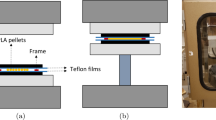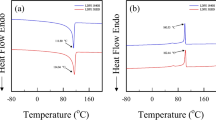Abstract
The shape recovery and shape fixity properties of shape memory polymers (SMPs), advanced functional materials, were investigated in this study. Although the shape recovery behavior of these polymers has been examined from a viscoelastic point of view, questions remain with regard to quantifying the recovery behavior of SMPs. SMPs can recover their shape after the molding process; this recovery occurs via creep recovery and/or shape recovery; an estimation of SMP recovery requires a good understanding of both processes. In this study, the time–temperature superposition principle was applied to the creep and shape recovery behavior of SMPs. The creep behavior was estimated using an experimentally obtained master curve and time–temperature shift factors. Our estimated results were in good agreement with the experimental data. However, the estimation of the creep recovery with changing temperature below or above the glass transition temperature was not successful due to the lack of consideration of the shape recovery behavior. The time and temperature dependency of the shape recovery were confirmed for creep behavior, using the master curve for the recovery ratio and the corresponding shift factors for shape recovery. The values of the shape recovery shift factors differed from those for the time–temperature shift factors obtained for creep behavior. Therefore, these shape recovery shift factors were used in the estimation of creep and shape recovery behavior using the master curve for the creep tests. The estimated results were closer to the results obtained experimentally. Moreover, our results indicated that the recovery behavior above \(T_{\mathrm{g}}\) was dominated by shape recovery as a result of polymer viscoelasticity.















Similar content being viewed by others

References
Arrieta, S., Diani, J., Gilormini, P.: Cyclic and monotonic testing of free and constrained recovery properties of a chemically crosslinked acrylate. J. Appl. Polym. Sci. 131, 39813 (2014a)
Arrieta, S., Diani, J., Gilormini, P.: Experimental characterization and thermoviscoelastic modeling of strain and stress recoveries of an amorphous polymer network. Mech. Mater. 68, 95–103 (2014b)
Azra, C., Plummer, C., Manson, J.: Isothermal recovery rates in shape memory polyurethanes. J. Smart Mater. Sruct. 20, 082002 (2011)
Diani, J., Liu, Y., Gall, K.: Finite strain 3D thermoviscoelastic constitutive model for shape memory polymers. Polym. Eng. Sci. 46, 484–492 (2006)
Diani, J., Gilormini, P., Fredy, C., Rousseau, I.: Predicting thermal shape memory of crosslinked network polymers from linear viscoelasticity. Int. J. Solids Struct. 49, 793–799 (2012)
Heuchel, M., Cui, J., Kratz, K., Kosmella, H., Lendlein, A.: Relaxation based modeling of tunable shape recovery kinetics observed under isothermal conditions for amorphous shape-memory polymers. Polymer 51, 6212–6218 (2010)
Hong, S.J., Yu, W.R., Youk, J.H., Cho, Y.R.: Polyurethane smart fiber with shape memory function: experimental characterization and constitutive modeling. Fiber Polym. 8, 377–385 (2007)
Kafka, V.: Shape memory polymers: a mesoscale model of the internal mechanism leading to the SM phenomena. Int. J. Plast. 24, 1533–1548 (2008)
Lendlein, A.S., Kelch, S.: Shape-memory polymers. Angew. Chem. 41, 2034–2057 (2002)
Lendlein, A.S., Kelch, S., Kratz, K., Schulte, J.: Shape-memory polymers. In: Encyclopedia of Materials, pp. 1–9. Elsevier, Amsterdam (2005)
Lin, J.R., Chen, L.W.: Shape-memorized crosslinked ester-type polyurethane and its mechanical viscoelastic model. J. Appl. Polym. Sci. 73, 1305–1319 (1999)
Liu, Y., Gall, K., Dunn, M.L., Greenberg, A.R., Diani, J.: Thermomechanics of shape memory polymers: uniaxial experiments and constitutive modeling. Int. J. Plast. 22, 279–313 (2006)
Monkman, G.J.: Advances in shape memory polymer actuation. Mechatronics 10, 489–498 (2000)
Morshedian, J., Khonakdar, H.A., Rasouli, S.: Modeling of shape memory induction and recovery in heat-shrinkable polymers. Macromol. Theory Simul. 14, 428–434 (2005)
Muller, W.W., Pretsch, T.: Hydrolytic aging of crystallizable shape memory poly(ester urethane): effects on the thermo-mechanical properties and visco-elastic modeling. Eur. Polym. J. 46(8), 1745–1758 (2010)
Nakayama, K.: Properties and application of shape-memory polymers. Int. J. Polym. Sci. Technol. 18, T43–T48 (1991)
Nguyen, T.D.: Modeling shape-memory behavior of polymers. Polym. Rev. 53, 130–152 (2013)
Nguyen, T.D., Qi, H.J., Castro, F., Long, K.N.: A thermoviscoelastic model for amorphous shape memory polymers: incorporating structural and stress relaxation. J. Mech. Phys. Solids 56, 2792–2814 (2008)
Otsuka, K., Wayman, C.M.: Shape Memory Materials. Cambridge University Press, New York (1998)
Sakai, T., Somiya, S.: Analysis of creep behavior in thermoplastics based on visco-elastic theory. Mech. Time-Depend. Mater. 15(3), 293–308 (2011)
Sakai, T., Tao, T., Somiya, S.: Viscoelasticity of shape memory polymer: polyurethane series DiARY®. J. Solid Mech. Mater. Eng. 1(4), 480–489 (2007)
Srivastava, V., Chester, S.A., Anand, L.: Actuated shape-memory polymers: experiments theory and numerical simulations. J. Mech. Phys. Solids 58, 1100–1124 (2010)
Struik, L.C.E.: Physical Aging in Amorphous and Other Materials. Elsevier, New York (1978)
Tobushi, H., Hashimoto, T., Hayashi, S., Yamada, E.: Thermomechanical constitutive modeling in shape memory polymer of polyurethane series. J. Intell. Mater. Syst. Struct. 8, 711–718 (1997)
Xu, W., Li, G.: Constitutive modeling of shape memory polymer based selfhealing syntactic foam. Int. J. Solids Struct. 47, 1306–1316 (2010)
Author information
Authors and Affiliations
Corresponding author
Rights and permissions
About this article
Cite this article
Sakai, T., Tao, T. & Somiya, S. Estimation of creep and recovery behavior of a shape memory polymer. Mech Time-Depend Mater 19, 569–579 (2015). https://doi.org/10.1007/s11043-015-9279-3
Received:
Accepted:
Published:
Issue Date:
DOI: https://doi.org/10.1007/s11043-015-9279-3



